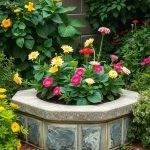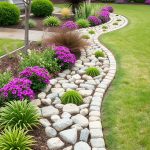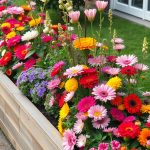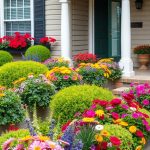Looking to add some charm to your garden without taking up too much space? Dive into these 21 small flower bed ideas that mix creativity with simplicity. Whether you have a tiny patio or a cozy backyard, you’ll find plenty of inspiring options to brighten up your outdoor area.
Butterfly Garden Flower Beds
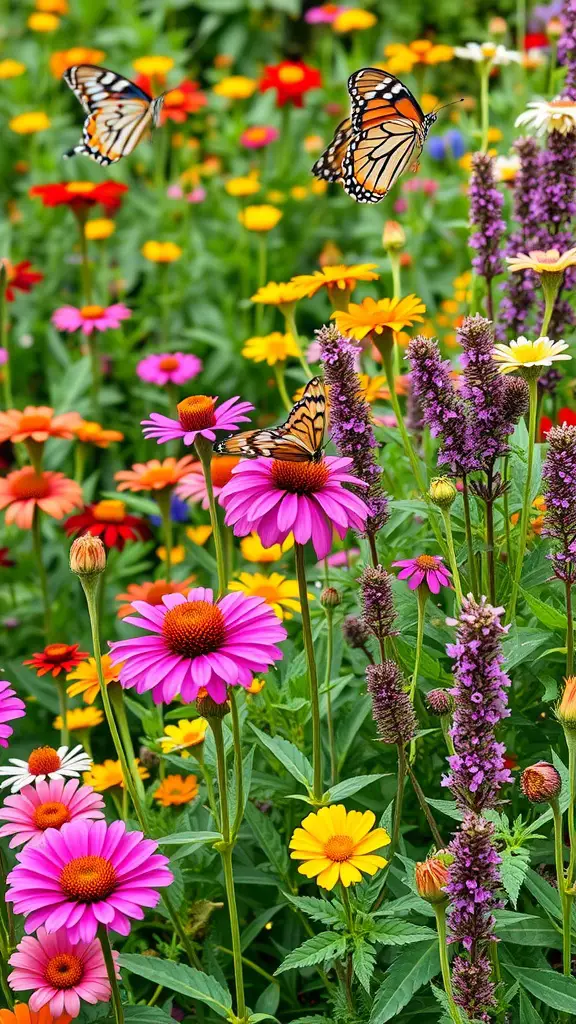
Creating a butterfly garden is a delightful way to invite nature into your yard. These flower beds can be both colorful and functional, attracting butterflies and other pollinators. The image captures a vibrant mix of flowers, with bright pinks, yellows, and purples, creating a lively atmosphere.
To design your butterfly garden, choose native flowers that bloom at various times throughout the season. This ensures a constant food source for butterflies. Popular choices include coneflowers, zinnias, and asters, which not only look beautiful but also thrive in most gardens.
Providing some open spaces and sunlit areas in your flower bed can help butterflies feel more at home. They love to bask in the sun, so consider arranging your plants to create sunny spots mixed with some shade. Adding a shallow dish of water or some rocks can also offer them a place to rest and hydrate.
With just a little planning, your flower bed can become a vibrant haven for butterflies, making your outdoor space even more enjoyable. Plus, watching these graceful creatures flit from flower to flower adds charm to any garden.
Border Flower Beds to Enhance Pathways
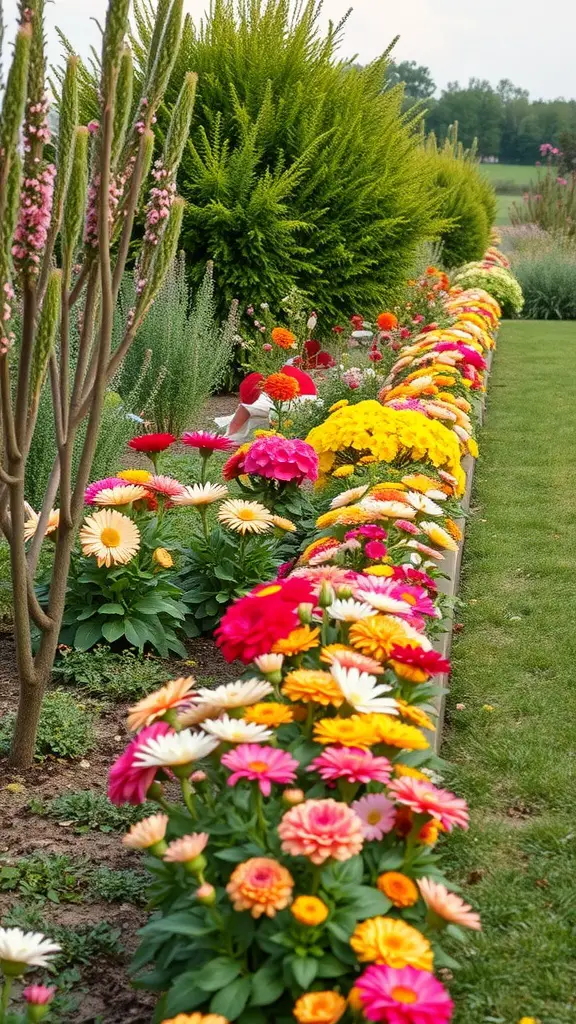
Border flower beds are a delightful way to frame your garden pathways. They not only enhance the beauty of your outdoor space but also guide visitors along the way. The image showcases a vibrant arrangement of flowers lining a pathway, creating a cheerful atmosphere.
In this flower bed, you can see a mix of colorful blooms, including zinnias and gerberas, which add pops of color that catch the eye. The varying heights of the flowers create visual interest, while the lush greenery in the background balances the bright hues. This combination makes any walk through the garden feel inviting.
When planning your border flower beds, think about color coordination and flower height. Taller plants can be placed at the back or center, while shorter ones work well in front. This ensures that all the flowers are visible, creating a fuller look. Experimenting with different flower types can also lead to unique combinations that reflect your personal style.
Using flowers in your border beds not only looks appealing but can also attract pollinators like bees and butterflies. This adds life and movement to your garden. So, grab your gardening tools and start creating a colorful border that will enhance your pathways!
Herb and Flower Combination Beds
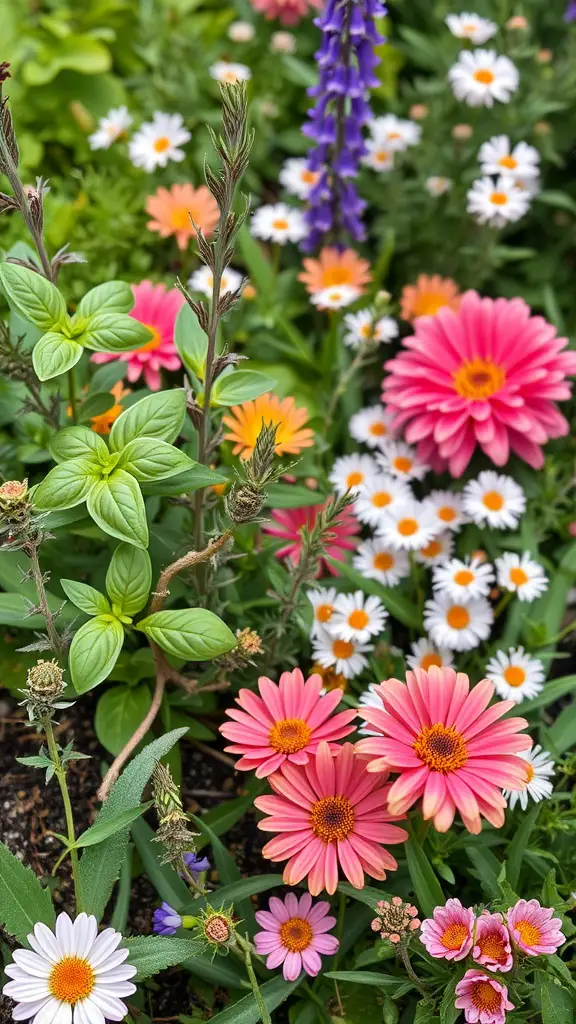
Creating a herb and flower combination bed adds both beauty and functionality to your garden. Imagine a vibrant display of colors alongside fragrant herbs. The image showcases a lovely mix of flowers, including pink daisies, white daisies, and bold purple blooms, all nestled around lush green basil leaves.
Herbs like basil not only smell wonderful but can also enhance your culinary creations. When planted alongside flowers, they attract beneficial pollinators like bees and butterflies, making your garden a lively ecosystem. Consider mixing herbs such as rosemary or thyme with colorful blooms to create a visually appealing and aromatic space.
To design your own herb and flower combination bed, choose flowers that bloom at different times. This will ensure that there’s always something flowering throughout the seasons. Aim for a mix of heights and colors for a dynamic look, just like the diverse flowers seen in the image.
Succulent and Cacti Bed for Drought Resistance
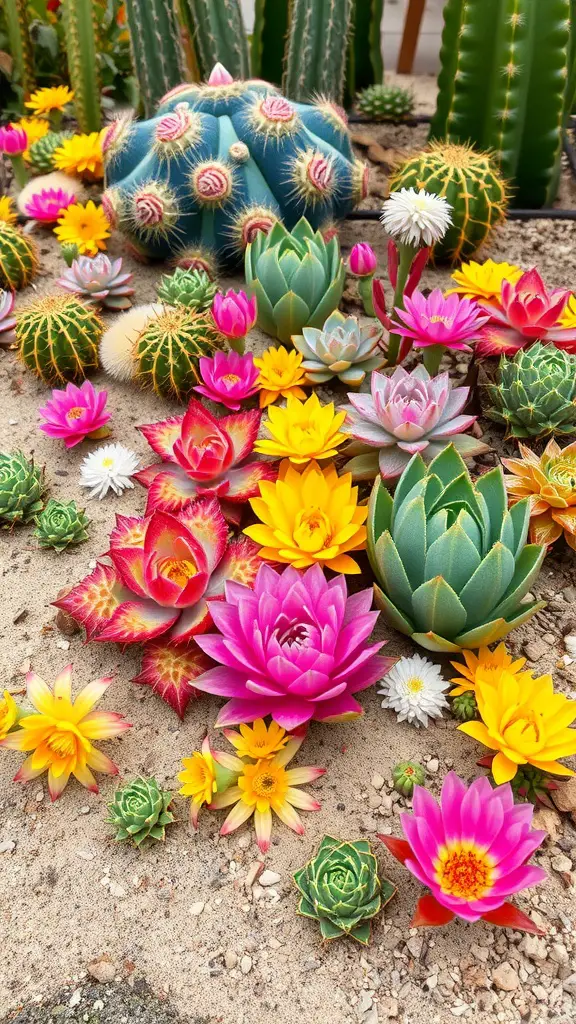
Creating a succulent and cacti bed is a smart choice, especially for those looking to conserve water and maintain a vibrant garden. These plants are not only drought-resistant, but they also add a splash of color and texture to your outdoor space.
In the image, you can see a delightful arrangement of various succulents and cacti in bright hues, ranging from deep pinks to sunny yellows. The mix of shapes and sizes creates visual interest while ensuring that the plants thrive in dry conditions. Succulents store water in their leaves, while cacti have adapted to live in arid environments, making them perfect companions.
When designing your succulent and cacti bed, consider using sandy or well-draining soil to prevent root rot. This type of soil allows excess water to flow away, helping your plants flourish. Arranging the plants in clusters can create a striking focal point, while also mimicking their natural habitats.
Additionally, incorporating decorative rocks or gravel around your plants can enhance drainage and add a finished look to your garden. Succulents and cacti come in many colors and forms, so feel free to mix and match to find the combinations that make your heart smile!
Rock Garden with Alpine Flowers
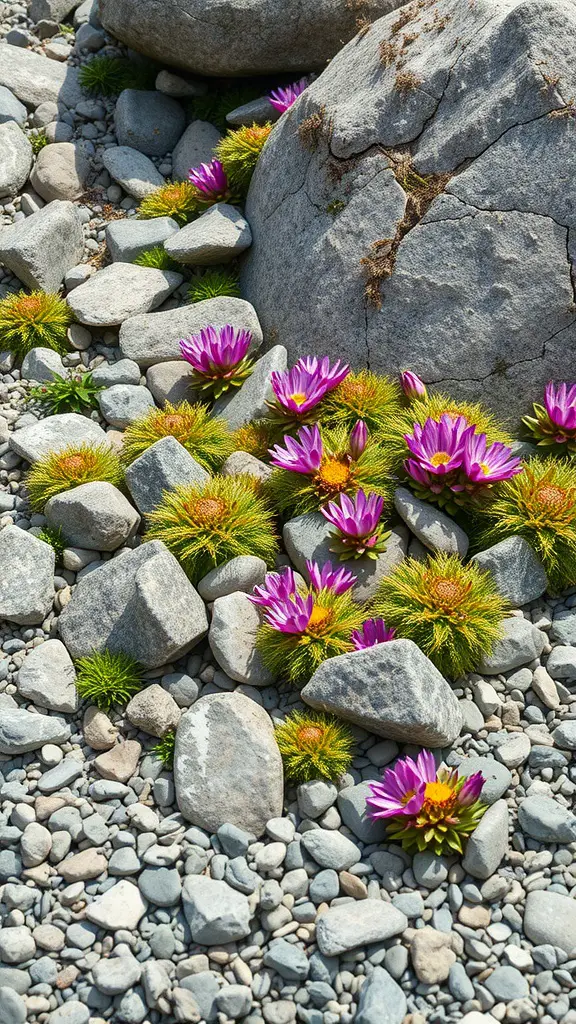
A rock garden filled with alpine flowers is a charming way to bring some color and texture to your outdoor space. The combination of rugged stones and delicate blooms creates a unique look that’s both natural and inviting.
In the image, you can see vibrant flowers peeking through the stones. These alpine varieties are perfect for rock gardens as they thrive in poor soil and don’t require much water. The pink hues of the flowers stand out beautifully against the gray rocks, adding a splash of life to the stones.
When designing your own rock garden, consider using a mix of different sized stones to create depth. Place larger boulders in the center, surrounded by smaller pebbles, and then dot the area with your favorite alpine flowers. This setup not only looks appealing but also provides a great habitat for small wildlife.
Succulents and moss can also be excellent additions, further enhancing the natural vibe. With minimal maintenance, a rock garden with alpine flowers can be a delightful feature in your yard, offering a serene spot to relax and enjoy nature.
Container Flower Beds for Patios
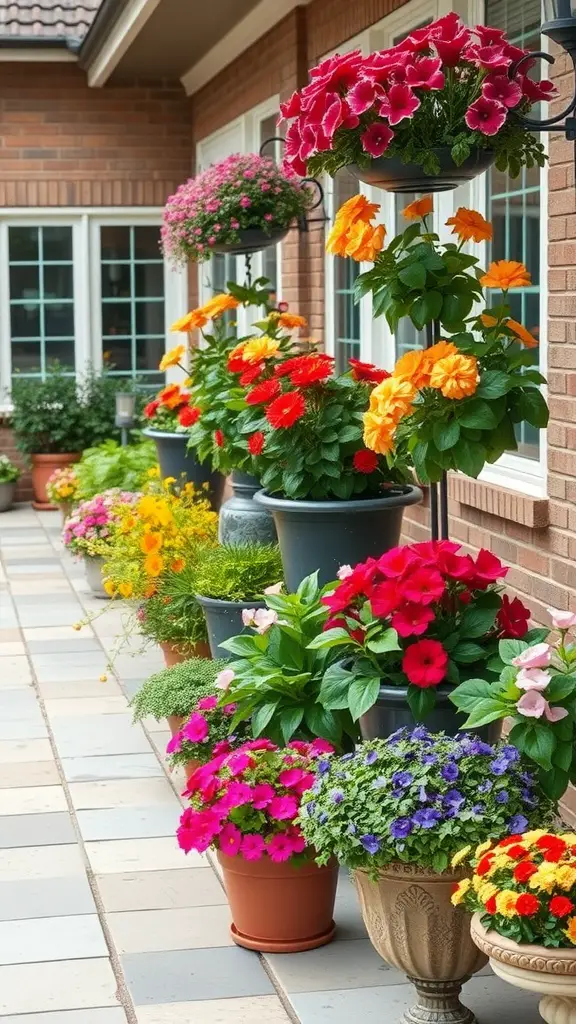
Container flower beds are a fantastic way to bring life and color to your patio. The image shows a vibrant array of flowers in various pots, creating a cheerful and inviting atmosphere. By using containers, you can easily change the look of your space without much effort.
Consider mixing different flower types and colors. The bold reds and yellows in the image are eye-catching and create a lively focal point. You can choose seasonal blooms to keep your patio looking fresh throughout the year.
Don’t forget about the height of your containers! Tall planters can add depth and dimension to your arrangement. Hanging baskets, like the ones shown, provide a beautiful way to display trailing flowers that soften edges and draw the eye upwards.
Managing your container flower beds is easy too. They often require less maintenance than traditional flower beds, and you can move them around to find the perfect spot for sunshine or shade. This flexibility makes them ideal for patios of any size.
Overall, container flower beds can transform your outdoor space into a cozy retreat. So grab some pots, pick your favorite flowers, and get planting!
Charming Cottage-Style Flower Beds
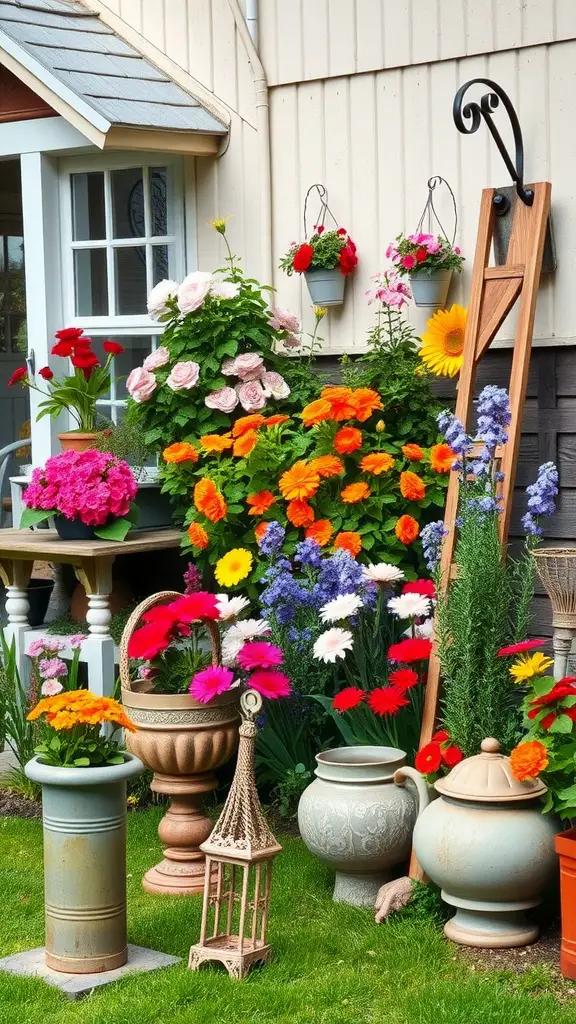
Cottage-style flower beds are all about creating a welcoming and cozy atmosphere. This image perfectly captures that charm with a delightful mix of colors and textures. The vibrant flowers, including cheerful sunflowers and soft pink roses, bring life to the space and invite anyone passing by to take a closer look.
Various pots and containers add a layered effect to the garden. Some are tall and elegant, while others are small and whimsical. This variety keeps the eye moving and engages your curiosity. The use of different sizes and shapes makes the arrangement feel more natural and less rigid, which is a hallmark of cottage gardens.
Incorporating accessories like the decorative lantern adds a nice touch of personality. It’s these little details that make your flower beds feel like home. Hanging planters also help to maximize space, allowing you to add even more blooms without needing a large area.
When creating your own charming cottage-style flower beds, think about mixing perennials and annuals for continuous blooms throughout the season. Choose colors that complement each other while also standing out. Remember, the goal is to create a lovely tapestry of flowers that feels both inviting and lively!
Vertical Flower Beds for Space Saving
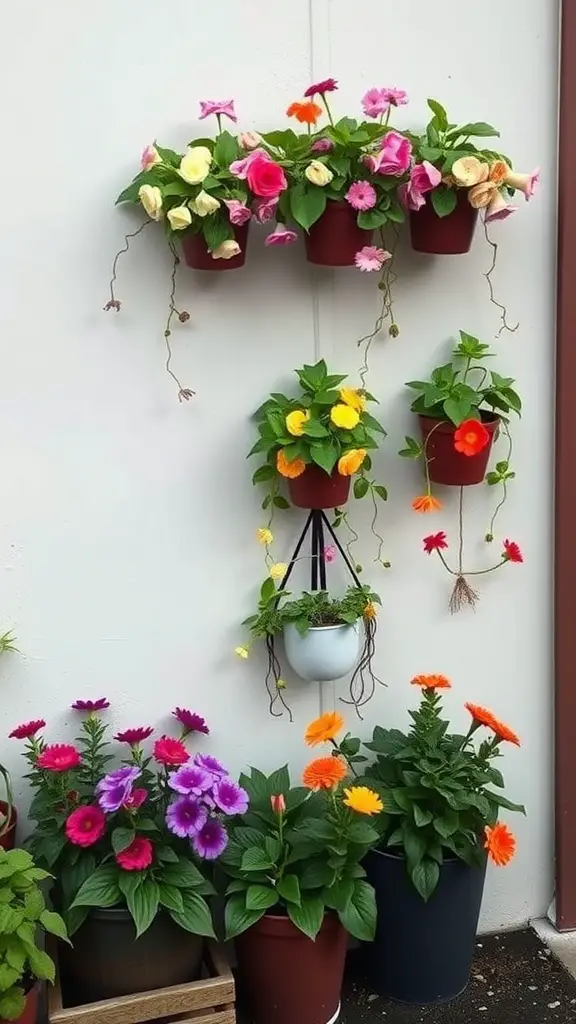
Vertical flower beds are a clever way to add beauty to small spaces. Just take a look at this setup! It features an array of colorful flowers in hanging pots, showcasing how you can maximize wall space while bringing life to any area.
The arrangement here displays both hanging and standing planters, creating a vibrant visual that draws the eye. This layering effect not only saves ground space but also adds depth to your garden design.
You can mix and match different flower types and colors, just like in the image. Flowers like petunias and begonias can thrive in vertical setups, adding a splash of color to your walls.
Combining various heights and styles can create a fun and inviting atmosphere. Plus, vertical gardens are easier to maintain, allowing you to enjoy your blooms without too much hassle.
Minimalist Flower Beds for a Modern Look
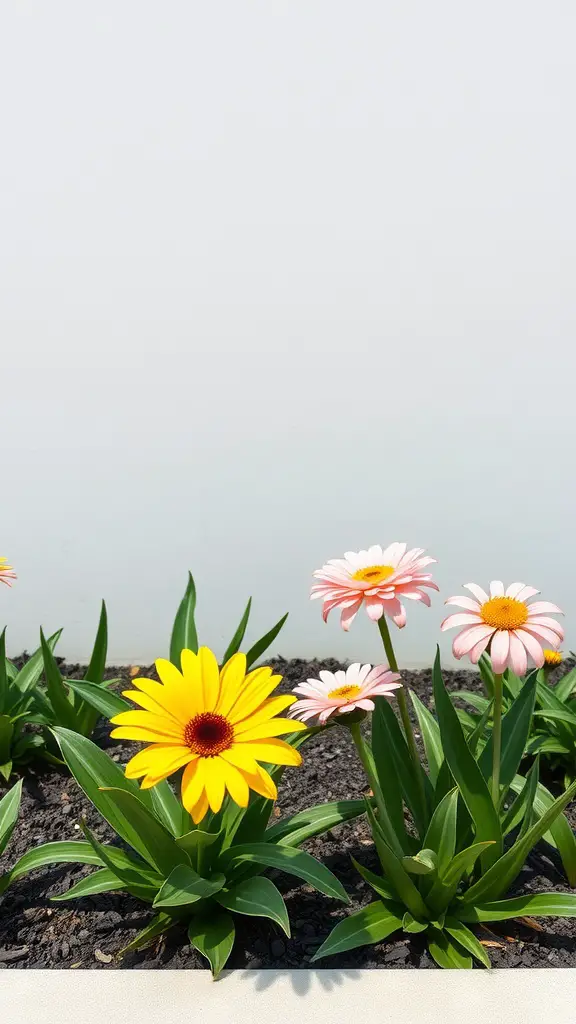
When it comes to creating a minimalist flower bed, simplicity is key. This image showcases a clean and modern approach, featuring bright yellow and soft pink flowers against a pristine white backdrop. The arrangement emphasizes the beauty of the flowers while keeping the overall design uncluttered.
In a minimalist design, choosing a few bold colors can make a big impact. The vibrant yellow flower steals the spotlight, drawing the eye and adding a cheerful touch. Meanwhile, the pink flowers provide balance without overwhelming the space. This combination is perfect for those who appreciate modern aesthetics.
To achieve a similar look in your garden, opt for a limited selection of flowers. Plant them in a way that allows each bloom to shine. Using dark soil, as seen in the image, can enhance the colors of the flowers, making them stand out even more. This design style is not just about the flowers; it’s about creating a serene environment that invites relaxation.
Wildflower Beds for Natural Beauty
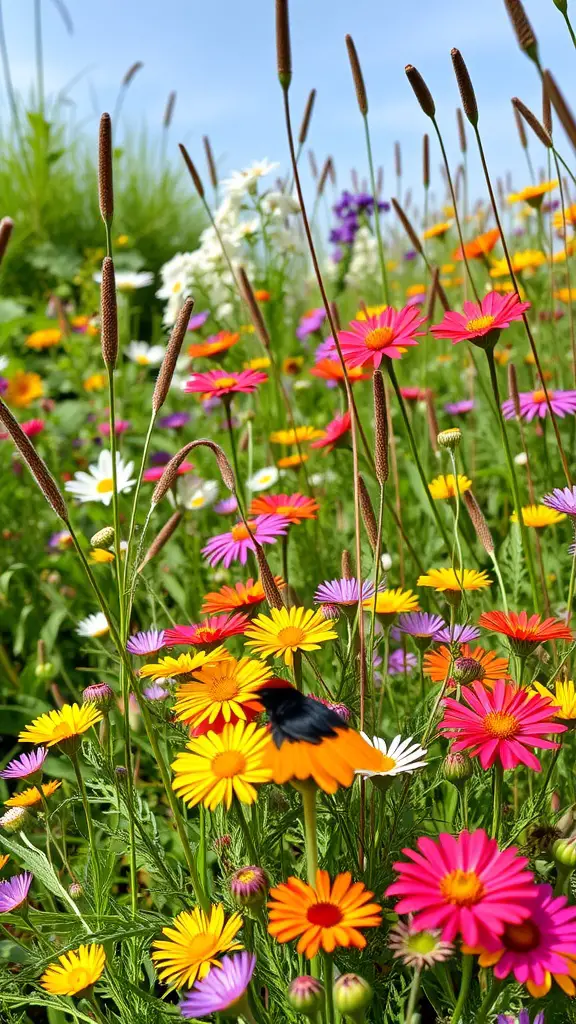
Wildflower beds are a delightful way to bring nature’s charm into your garden. These vibrant patches of color create a relaxed and inviting atmosphere. The image captures a lively mix of flowers blooming in various shades, showcasing the beauty of nature in full swing.
Creating a wildflower bed is simple and requires minimal maintenance. Start by selecting a sunny spot in your yard. Scatter a mix of wildflower seeds—think sunflowers, daisies, and poppies—over the soil. As you watch them grow, you’ll enjoy a colorful display that attracts butterflies and bees, supporting local wildlife.
Wildflower beds also enhance biodiversity. They create a habitat for beneficial insects, which can improve the health of your garden. This natural beauty adds a unique touch to your outdoor space, making it feel alive and welcoming.
So, whether you have a small corner or a larger area to work with, consider planting a wildflower bed. It’s an easy way to embrace the beauty of nature right in your backyard!
Shady Flower Beds for Low-Light Areas
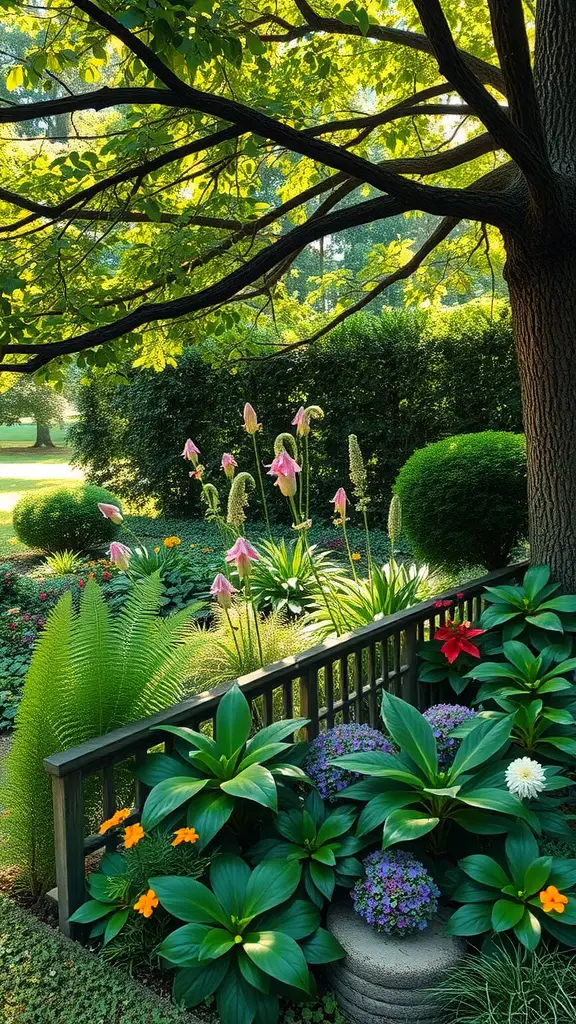
Creating beautiful flower beds in shady spots can be both fun and rewarding. In the image, you can see a lovely arrangement of flowers nestled under a tree, showcasing how even low-light areas can come to life with color and texture.
The flowers here vary in height and type, with some taller blooms reaching for the light while shorter plants create a lush base. This mix adds depth to the flower bed, ensuring it catches the eye even without direct sunlight. The greenery from ferns and broad leaves provides a nice contrast, making the vibrant flowers stand out even more.
If you’re thinking about planting in a shady area of your garden, consider using plants like hostas, heucheras, and astilbes. They thrive in lower light and still bring a pop of color. Mixing different leaf shapes and sizes will add interest to your flower bed, just like in the photo!
Remember, it’s essential to choose the right plants for your specific conditions. Observe how much light your shaded area receives throughout the day. This knowledge will help you pick the best flowers that will flourish in your unique setting.
Seasonal Flower Beds for Year-Round Interest
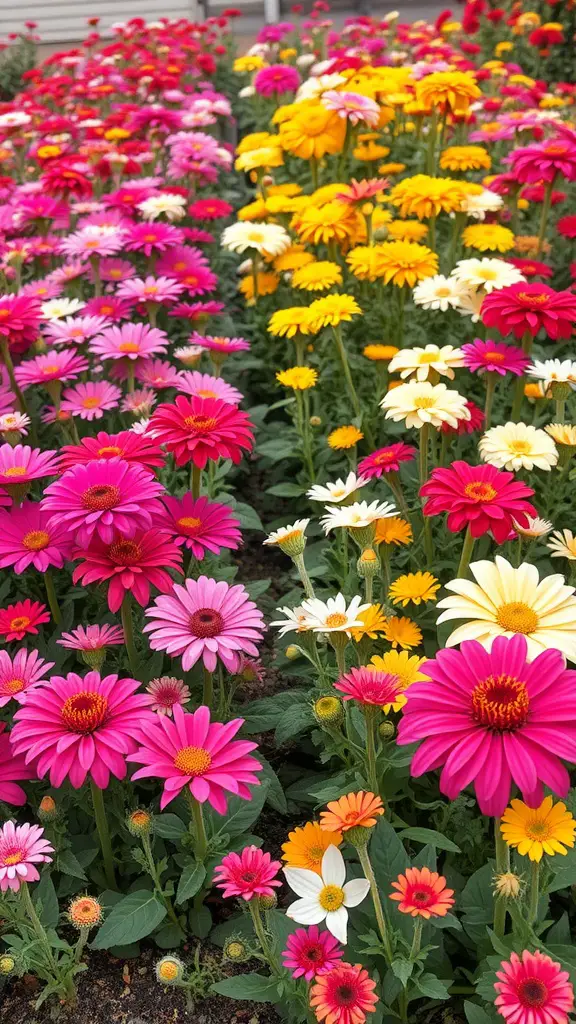
Creating a flower bed that looks good all year can be a fun project. The image shows a vibrant display of flowers in various colors, showcasing how seasonal blooms can come together. Here, bright pink, yellow, and white flowers are arranged in a cheerful layout, providing an eye-catching sight.
To achieve a similar look, consider mixing early bloomers like daffodils with summer favorites such as daisies and chrysanthemums. This way, your garden will be alive with color from spring through fall. Try to select flowers that have different blooming periods, so there’s always something in bloom.
Incorporating some evergreens or hardy perennials can also bring structure and greenery to your flower bed during the colder months. Don’t forget to add some mulch to help retain moisture and keep the weeds at bay. A well-planned flower bed will bring joy not just to you, but to all who pass by!
Edible Flower Beds for Culinary Use
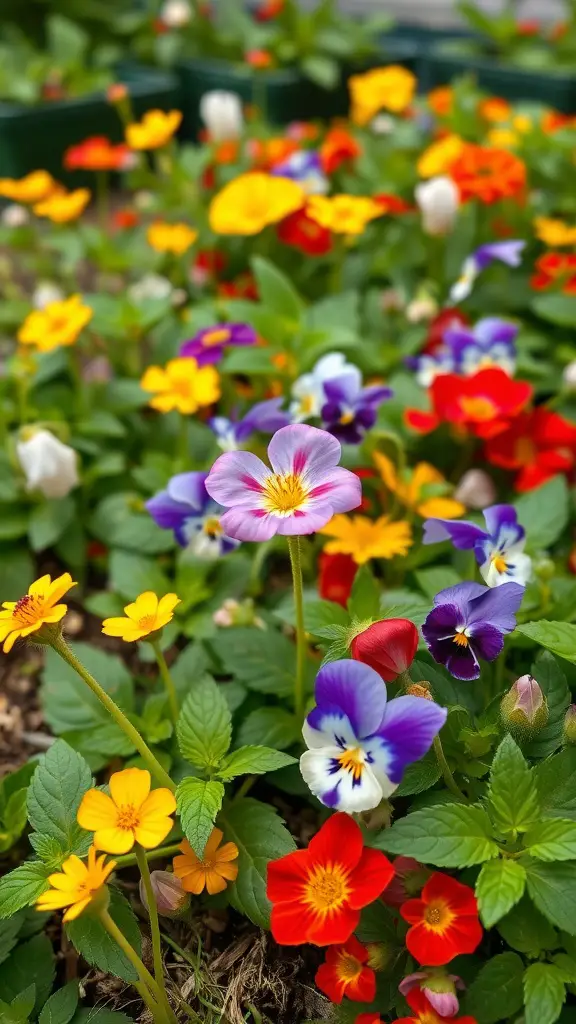
Imagine stepping into your garden and seeing a vibrant mix of colors from edible flowers. The image beautifully showcases a variety of blooms in shades of purple, red, yellow, and orange, creating a lively and inviting atmosphere. These flowers not only add beauty but also flavor to your dishes.
Edible flowers can enhance salads, desserts, and even drinks. Think about tossing some vibrant pansies or nasturtiums into your next salad for a pop of color and a peppery taste. Their unique flavors can elevate simple dishes into something memorable.
To create your own edible flower bed, start with easy-to-grow options like nasturtiums, violets, and calendula. Make sure to plant them in a sunny spot with well-draining soil. Water them regularly and watch as they flourish.
Once your flowers bloom, use them fresh in your cooking. You can create a delightful floral salad by mixing greens with edible blooms and a light vinaigrette. Alternatively, freeze flowers in ice cubes for a lovely touch to your summer drinks.
Creating an edible flower bed isn’t just about aesthetics; it’s about bringing your culinary creations to life. So, gather your seeds, get planting, and enjoy the beauty and flavor that comes from your garden!
Mixed Perennial and Annual Flower Beds
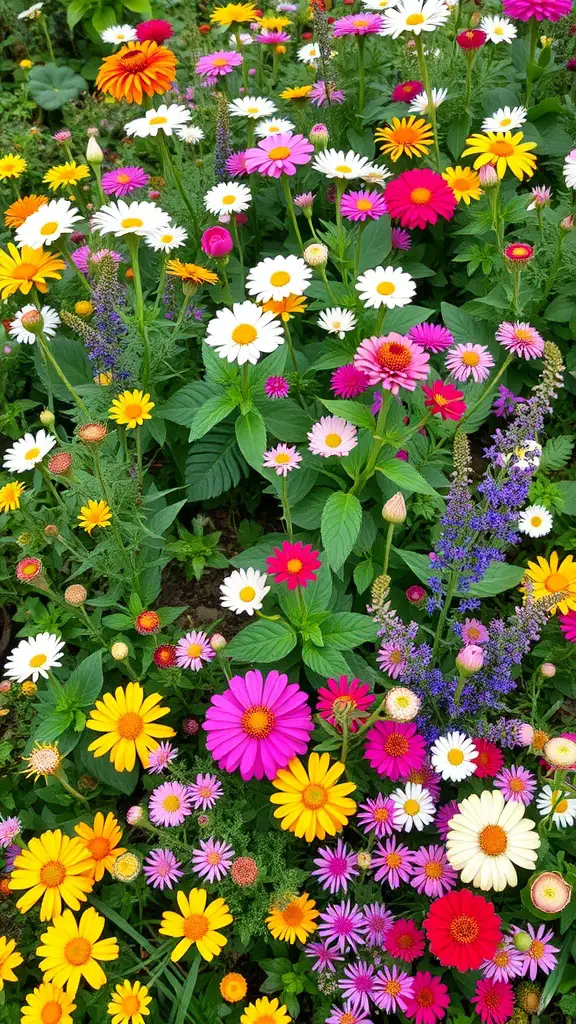
Creating a mixed flower bed with both perennials and annuals can bring a lively burst of color to your garden. The image here shows a vibrant array of blooms, showcasing how different flowers can coexist beautifully. You’ll find daisies, zinnias, and various colorful asters all mingling together.
By combining perennial plants that return year after year with annuals that bloom for just a season, you can achieve a continuously changing scenery. This mix not only adds depth but also extends the blooming season. For instance, you might plant perennials like daisies that bloom in spring alongside annuals like zinnias for late summer color.
Mixing different heights and shapes of flowers can also make your garden more visually interesting. Taller flowers can provide a backdrop for shorter ones, creating layers that draw the eye. Using this technique, you can create a flower bed that feels lush and full, as seen in the image.
When planning your flower bed, consider the light and soil conditions of your garden. Some flowers thrive in full sun while others prefer partial shade. This will help ensure your flower bed flourishes throughout the growing season.
Color-Themed Flower Beds for Visual Impact
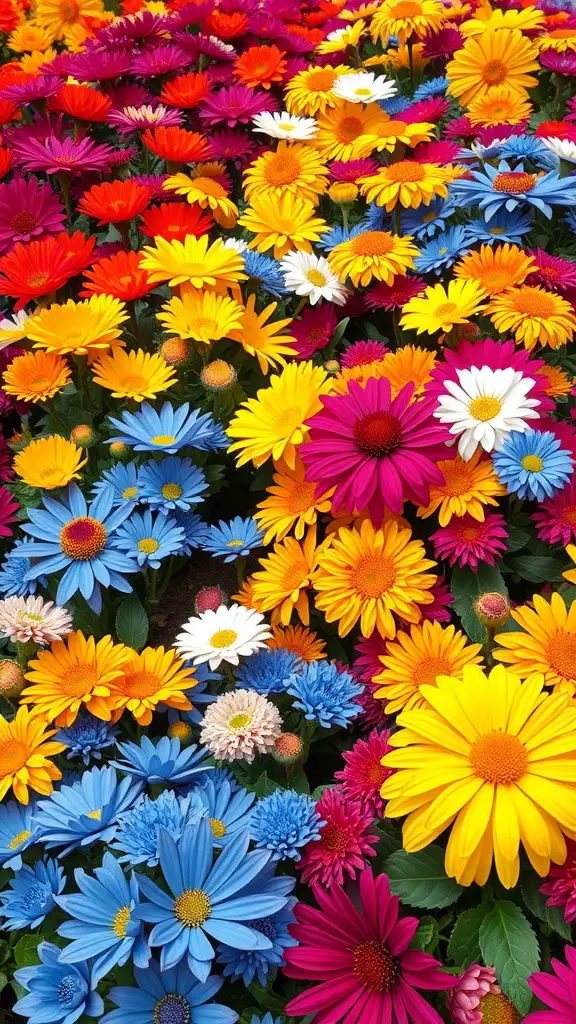
When it comes to flower beds, color can make all the difference. A well-planned arrangement of vibrant blooms can transform any outdoor space into a visual delight. The image above showcases a dazzling mix of flowers in bright hues of red, yellow, blue, and pink. This lively color palette not only catches the eye but also lifts the spirit, creating an inviting atmosphere.
Choosing a color theme for your flower bed can help you convey a specific mood or style. For instance, warm colors like reds and yellows can create a cheerful vibe, while cool colors like blues and purples evoke calmness. In the image, the blend of warm and cool shades harmonizes beautifully, making it a perfect example of how to balance colors in your garden.
Consider grouping flowers with similar colors or alternating between contrasting ones. This can highlight the unique shapes and textures of each bloom, adding depth to your garden. The combination of large sunflowers and smaller daisies in the picture illustrates how varying flower sizes can enhance the overall design.
To maintain the impact of your color-themed flower bed, think about the seasonal changes. Some flowers bloom at different times, so plan accordingly to ensure a continuous display of color throughout the seasons. With careful selection and arrangement, you can create a captivating flower bed that brings joy all year round.
